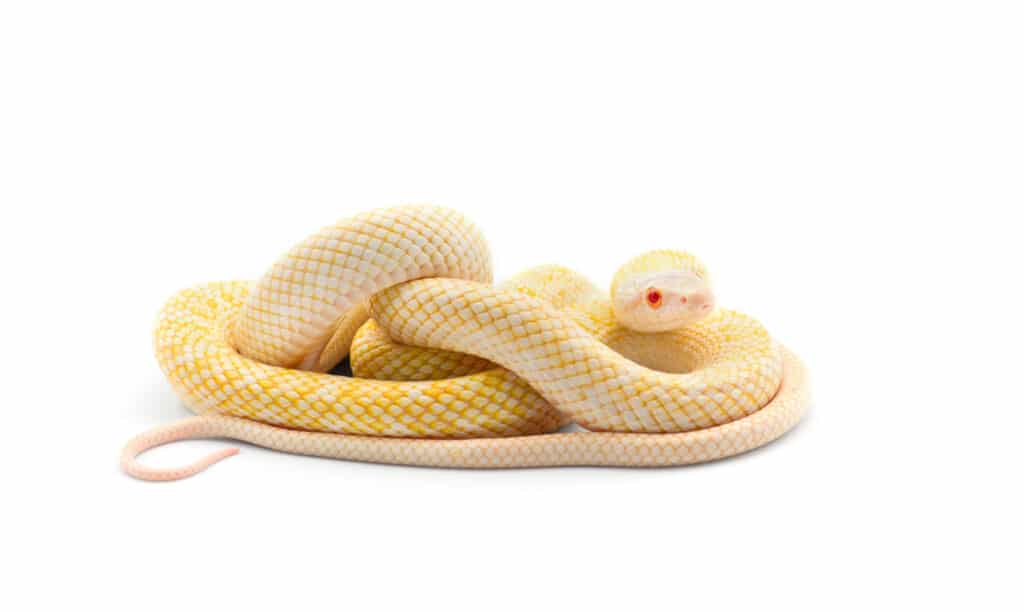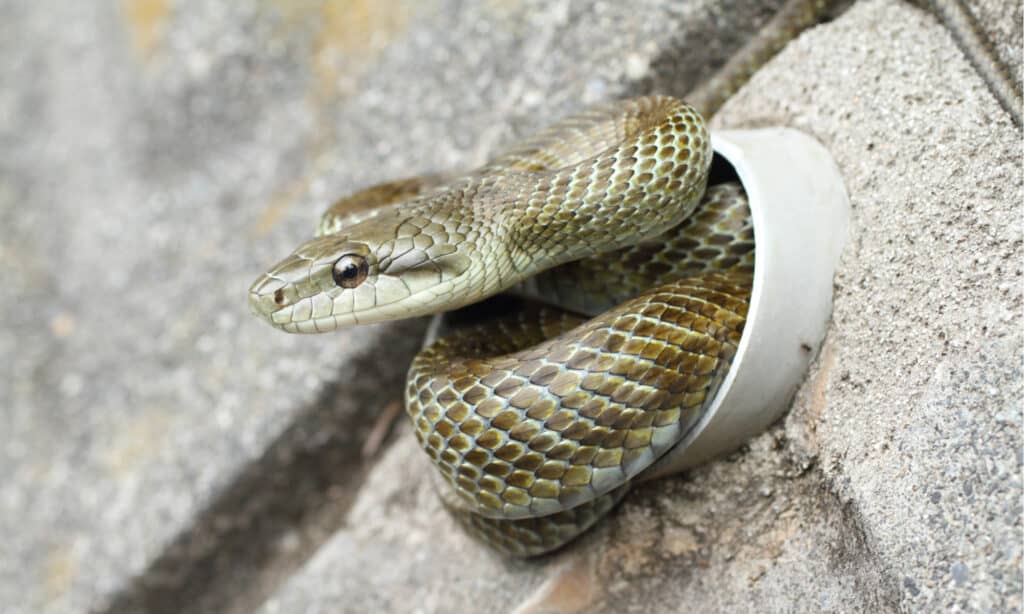Japanese rat snake
Elaphe climacophora
The albino Japanese rat snake is a symbol of good luck.
Advertisement
Japanese rat snake Scientific Classification
- Kingdom
- Animalia
- Phylum
- Chordata
- Class
- Reptilia
- Order
- Squamata
- Family
- Colubridae
- Genus
- Elaphe
- Scientific Name
- Elaphe climacophora
Read our Complete Guide to Classification of Animals.
Japanese rat snake Conservation Status
Japanese rat snake Facts
- Prey
- Rats, lizards, frogs
- Fun Fact
- The albino Japanese rat snake is a symbol of good luck.
- Litter Size
- 7-20 eggs
Japanese rat snake Physical Characteristics
- Color
- Brown
- Yellow
- Blue
- Green
- Skin Type
- Scales
- Lifespan
- Up to 13.1 years
- Venomous
- No
- Aggression
- Low
View all of the Japanese rat snake images!
“The albino Japanese rat snake is a symbol of good luck”
The Japanese rat snake is sometimes called the blue general because some of them have bright blue scales. It is non-venomous and lives in shrubland, forest, or mountain habitat. This snake can grow to a size of 6.5 feet. It lives in Japan and on Kunashir Island. These snakes eat rats, frogs, and lizards.
4 Japanese Rat Snake Amazing Facts
- It is known for climbing high into trees and taking baby birds out of their nests
- Tanukis and eagles are both predators of this snake
- Its Japanese name is aodaisho meaning blue general
- The albino type of this snake living on Kunashir Island is considered a sign of good luck
Where to Find Japanese Rat Snake
The Japanese rat snake lives on the Hokkaido, Honshu, Kyushu, and the Shikoku Islands of Japan. In addition, they live on Kunashir Island.
It lives in a forest habitat where it easily climbs high into the branches to hunt or rest. It’s considered an arboreal snake because it spends so much of its life in the trees. Plus, this reptile’s dark scales allow it to blend in with its leafy surroundings. These snakes can also thrive in shrubland, field, or mountain habitat.
Japanese rat snakes go into brumation for three or four months to avoid the cold weather and store energy for breeding in the summertime.
This snake’s native countries are:
- Japan (Islands of Hokkaido, Honshu, Kyushu, and Shikoku)
- (Russia controlled) Kunashir Island
Japanese Rat Snake Scientific Name
Elaphe climacophora is the scientific name of the Japanese rat snake. In Japan, its name is aodaisho which translates to blue general referring to its bright blue scales. It’s in the Colubridae family and the Reptilia class.
The Colubridae family is a very large family of snakes. The Japanese rat snake is one of 17 belonging to the Elaphe genus within the Colubridae family. Others include:
- Elaphe anomala
- Elaphe bimaculate
- Elaphe cantoris
- Elaphe carinita
The Different Types of Rat Snake
The Japanese rat snake is one of 17 in the Elaphe genus. Many other types of rat snakes live in the southeastern region of the world. Some examples:
- Korean Rat Snake (Elaphe anomala): This snake makes its home in China and Korea. It has the same type of habitat as a Japanese rat snake but is a little smaller in size at up to six feet long.
- Twin Spotted Rat Snake (Elaphe bimaculata): The twin spotted rat snake sometimes has both spots and stripes on its body. It lives in the forests of China. It’s smaller in size than most rat snakes at two to two and a half feet long.
- Keeled Rat Snake (Elaphe carinata): It lives in a forest or mountain habitat in China, Japan, and Taiwan. This snake is known for its ability to release an odor to deter predators. It’s very large in size growing as long as 7.9 feet.
Japanese Rat Snake Population and Conservation Status
The total number of Japanese rat snakes is unknown, but biologists describe it as common in Japan. However, on Kunashir Island, its numbers are decreasing due to habitat loss. In general, this snake’s population is stable, and it has a status of Least Concern.
How to Identify a Japanese Rat Snake: Appearance and Description

The albino Japanese rat snake is a symbol of good luck.
©PetlinDmitry/Shutterstock.com
These rat snakes vary in appearance. Some have a mixture of yellow and green scales while others have a combination of bright blue and green scales. Instead of having a defined, splotchy pattern, this snake’s colors blend into one another making it a mixture of different shades. Juvenile Japanese rat snakes have brown striped scales. Both adults and juveniles have a white or cream-colored belly.
As a note, there is an albino type of this snake. It’s all white with pink eyes. Pink eyes are the norm in albino animals. One example is the albino rat. Many of these snakes live in Iwakuni (in Japan) and are known as Iwakuni white snakes.
This snake has a thick body measuring about two inches wide. They range from 3.2 feet in length to 6.5 feet. They have round pupils. The size of this snake differentiates it from others in the region. Outside of Okinawa, it’s known as the biggest Japanese snake.
How to identify this rat snake:
- Yellow and green scales
- Bright blue and green scales
- A light-colored belly
- Round pupils
Japanese Rat Snake Pictures

.
©PetlinDmitry/Shutterstock.com

©yamaoyaji/Shutterstock.com

©23frogger/Shutterstock.com
Japanese Rat Snake: How Dangerous Are They?
This rat snake is not venomous. It has a timid temperament. In other words, if this snake is approached by a person or a predator, its first reaction is to escape. Its dark colors give it an advantage in blending in with the leaves and branches in its forest habitat.
But, like most animals, if this snake feels it’s in danger, it can issue a painful bite. The lack of venom makes a bite less dangerous than other types of snakes. If a person is bitten, the first thing to do is stop the bleeding by putting pressure on the wound with a cloth. Once it stops bleeding, it’s necessary to wash the injury with soap and water to prevent it from becoming infected. A clean bandage should be applied to keep dirt and other debris out of the wound until it heals.
If the wound turns bright red or a rash develops, the person should see a doctor for further treatment.
Japanese Rat Snake Behavior and Humans
These snakes are a welcome sight to many farmers. They are excellent at capturing rats, mice, and other rodents on a farm or in the fields. An overpopulation of rodents on a farm can eat valuable crops, seeds, and grain.
These rat snakes have a shy temperament. If someone sees one crossing a field or shrubland in search of food, the snake is likely to try to escape to a tree or hide in the brush.
This rat snake is kept as a pet because of its mild temperament.
Similar Animals
View all 36 animals that start with JJapanese rat snake FAQs (Frequently Asked Questions)
Are Japanese rat snakes venomous?
No. Japanese rat snakes don’t have venom.
How do Japanese rat snakes hunt?
These snakes move very quickly, especially when in a tree. They are constrictors, wrapping around a rodent, frog, or other prey. Once the prey is dead, this snake swallows it whole.
Are Japanese rat snakes aggressive?
No, these snakes are known to have a timid temperament.
Where do Japanese rat snakes live?
The Japanese rat snake lives on the Hokkaido, Honshu, Kyushu, and the Shikoku Islands of Japan. In addition, they live on Kunashir Island.
They have a forest habitat and live in the shrublands, grasslands, and in mountains.
What do Japanese rat snakes eat?
These snakes eat rats, mice, and other rodents along with birds and frogs.
How big do Japanese rat snakes get?
These snakes can grow as long as 6.5 feet! They are strong, muscled snakes with a two-inch wide body.
How do you take care of a Japanese rat snake?
Someone who has a Japanese rat snake as a pet must make sure its habitat maintains a temperature from 77 degrees Fahrenheit to 82 degrees Fahrenheit. In addition, this snake needs a hot spot of around 85 degrees Fahrenheit for basking in (higher) heat. It’s typical for snakes in the wild to spend time basking in the sunlight to warm themselves.
The habitat of this pet snake should also be kept humid. The temperature and humidity can be monitored using portable gauges.
Substrate (bedding), lighting, and the proper food of frozen or live rodents are also essential for this snake.
Someone keeping this snake as a pet should certainly have an enclosure that provides it with plenty of space to accommodate its large size.
How strong is a Japanese rat snake?
These snakes are very strong. It doesn’t just drag its 3.5-to-6.5-foot body along behind it. If you take a bit of time to watch this snake in a video, you’ll see the muscles in every part of its body are at work as it moves along. Because it’s a constrictor, its two-inch-wide body is especially strong giving it the ability to squeeze its prey.
Thank you for reading! Have some feedback for us? Contact the AZ Animals editorial team.
Sources
- Wikipedia, Available here: https://en.wikipedia.org/wiki/Japanese_rat_snake
- IUCN Redlist, Available here: https://www.iucnredlist.org/species/47755764/47755773
- Wikipedia, Available here: https://en.wikipedia.org/wiki/Elaphe
- EOL, Available here: https://eol.org/pages/794923
- The Reptarium, Available here: https://thereptarium.com/pages/albino-kusinir-island-ratsnake
- Kansai Scene, Available here: https://www.kansaiscene.com/2012/12/snake-spotting-in-kansai/
- Reptile Talk, Available here: https://www.reptiletalk.net/japanese-ratsnake/

















